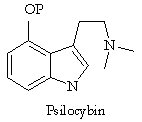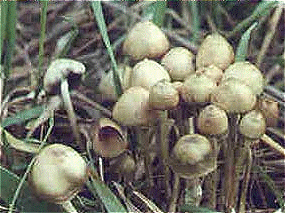

Hallucinogens and Mind Altering Substances
"'Mille phantasmata et doemonum observatium effigies circumspectarent.' This description of the hallucinogenic effects elicited by the Aztec 'magical' preparation ololiuqui, was recorded by Francisco Hernandez, (royal physician to Philip II of Spain). He carried out extensive investigations on the flora and fauna of Mexico during the years 1570-75, and his report Rerum Medicarum Novae Hispaniae Thesaurus was finally published in 1651. It contains a detailed description of the preparation and use of ololiuqui, and he notes that: 'when the priests want to commune with their gods and receive a message from them...they ate this plant; and a thousand visions and satanic hallucinations appeared to them.'
Numerous more recent studies have been made of the rituals associated with the collection and use of psychoactive plant extracts, and ethnobotany and ethnopharmacology are now well respected scientific disciplines. Use of such potions was, and still is, largely confined to Central and South America, especially Mexico, though there is no lack of candidate plants in the Old World. This difference is most likely cultural, since the rise of the strong monotheistic religions, primarily Judaism, Christianity, and Islam, removed the necessity for a belief in the spirit world and for the associated shamanistic rituals.
A totally satisfying classification of the various psychoactive substances is difficult. The German toxicologist and phsiologist Lewis Lewin assigned them to five categories: excitantia, inebriantia, hypnotica, euphorica and phantastica. Albert Hoffman, the discoverer of LSD, described them as stimulants, intoxicants, hypnotics, sedatives and tranquilizers, analgesics and euphoriants, and psychotomimetics and hallucinogens."
Excerpt taken from Murder, Magic & Medicine by John Mann


There are currently more than 180 types of psychoactive mushrooms that contain psilocybin or psilocin. Mushrooms have only about 1% of the potency of LSD, however the subjective effects are very similar. Like peyote, mushrooms are very important in some Indian ceremonies, especially that of the Mazatec Indians in Mexico.
Mescaline is the psychoactive component of the peyote cactus, Lophophora williamsii or Lophophora diffusa. Peyote has been traditionally used in many Mexican tribes and Native American tribes in ritual ceremonies four thousands of years. Many shaman used this plant to communicate with the gods. To learn more about peyote, read this essay.
Links to Mind Altering Sites
Cultural Role of Peyote in the Native American Society
Back to the Natural Products Vault Homepage